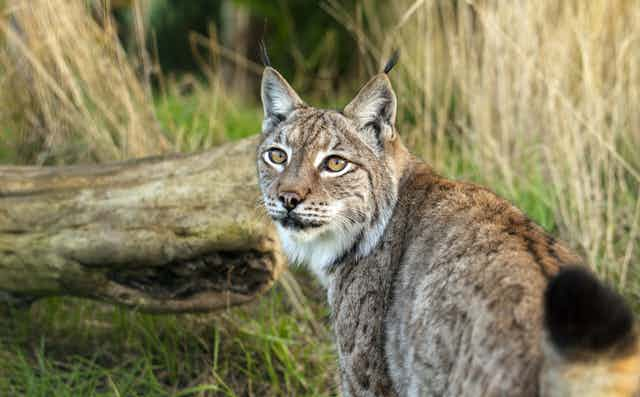On July 6, a two-year-old male Eurasian lynx named Flaviu escaped from his enclosure less than 24 hours after arriving at Dartmoor Zoo in Devon, south west England. He has been on the run ever since.
Zoo officials are confident Flaviu will remain nearby, and consequently the drones, sniffer dogs and humane traps baited with meat that are being used in the attempt to recapture him have focused on woods and farmland surrounding the zoo. Benjamin Mee, the zoo’s owner, believes the lynx will not venture far as there is plenty of easily accessible food in the form of rabbits and birds.
But I want to suggest an alternative possibility: perhaps he’s heading home.
Prior to arriving at Dartmoor Zoo, Flaviu lived with his mother, Klementyna, at the Port Lympne Reserve in Canterbury, Kent. He has been branded a “mummy’s boy” because of the close relationship he had with Klementyna. Consequently, Dartmoor zoo is planning to use bedding from his mother’s enclosure and a recording of her call to try and lure him back. Mee himself has acknowledged that Flaviu’s attachment to his mother may have been his motivation for wanting to escape, stating “we think he is really missing his mum. That is why he could have escaped last week, because he was trying to get back to her”.

Despite recognising Flaviu may have been motivated to escape because he missed his mother, zoo officials and others responsible for conducting the search are not seriously entertaining the possibility that he now might try to return to his previous home. Lynx are typically solitary in the wild and so the expectation is that as a two-year-old male, he would be more interested in finding his own territory.
However, having been born in captivity, Flaviu may not behave as a typical wild lynx. Animal welfare organisations such as the Blue Cross and Cats Protection emphasise that moving home is a very stressful procedure for domestic felines and consequently advocate keeping them indoors for at least three weeks following a move. The internet is full of stories of domestic cats travelling long distances and ending up back at their former residences.
Port Lympne is just over 275 miles from Dartmoor Zoo. Given the documented distances covered by wild lynx, Flaviu could feasibly turn up at his mother’s home some time in late August. The most recent sighting of Flaviu was on July 15, 12 miles north of Dartmoor zoo. If he is heading home his progress is slow, but this is perhaps unsurprising for a young animal experiencing freedom for the first time.
A petition is calling for Dartmoor Zoo to return Flaviu to Port Lympne (if and when he is recaptured) so that he can be reunited with his mother. Certainly if Flaviu makes his own way back to Port Lymphe then this argument would be strengthened considerably. And there is precedent for animals who escape from captivity or slaughter against the odds being granted a reprieve. For example, in 1998 two Tamworth pigs escaped from a slaughter house and went on the run for five days before being recaptured. The considerable media attention their escape received resulted in the pair being transferred to an animal sanctuary.
However, the reality for most captive animals belonging to endangered species is that they frequently get moved between zoos and other institutions according to the requirements of international breeding programmes. Flaviu and Klementyna cannot breed together, and so Flaviu’s fate if he is recaptured may well be determined by the value of his genes.
There is, of course, the risk that Flaviu will meet a sticky end if he is not recaptured. Certainly, many escapee carnivores end up being shot, or hit by cars, and trophy hunters are reportedly trying to “bag” the runaway lynx.
What else is out there?
At some point, Flaviu may encounter the mythical “Beast of Dartmoor”. While local folklore speaks of various demonic black hounds, the “beast” is more frequently assumed to be a big cat or cats whose existence is corroborated and contested in equal measure by regular sightings and inconclusive photographs. Mee himself claims that in the 1980s, before he took over the zoo, it released three pumas.
Academic research into sightings and predations suggests they are indeed flesh and blood creatures. For example, forensic tests conducted by a former colleague found that the tooth marks on sheep carcasses brought to her by confused farmers in Wales could be traced to multiple sources including foxes but also medium sized cats such as lynx or leopard.
During my own research in Wales, which consisted of interviews with over 60 individuals who had claimed to have seen or encountered big cats, I also found myself face to face with what I can only conclude was a big cat.
In the south west of England, and Dartmoor specifically, sociologist Adrian Franklin has conducted extensive interviews with individuals who have encountered big cats and discovered that there was historical precedent for big cats in private collections being released or escaping in the vicinity. If any of these escapees are still alive, and if any were lynx (as descriptions often suggest), then there’s a possibility Flaviu may not head home and chose instead to settle in the area and start his own family.
Finally, if Flaviu is not caught then his story might also become an interesting case study which could inform discussions surrounding the rewilding of lynx in the UK. If he remains at large, stays out of sight and doesn’t eat too many sheep or domestic pets, then UK residents might be more inclined to feel positive about coexisting with these creatures who were once native to the UK but were wiped out by human activity more than 1,300 years ago.

